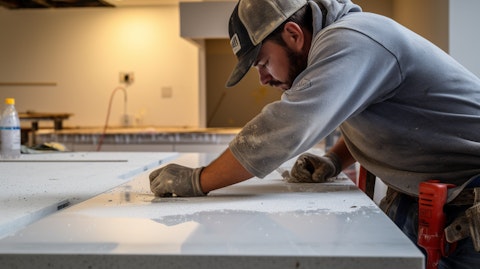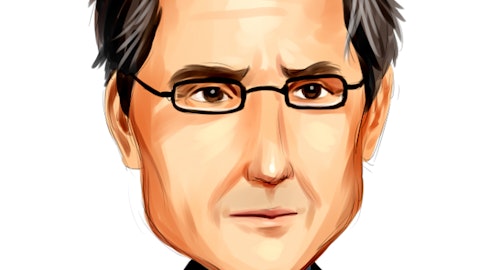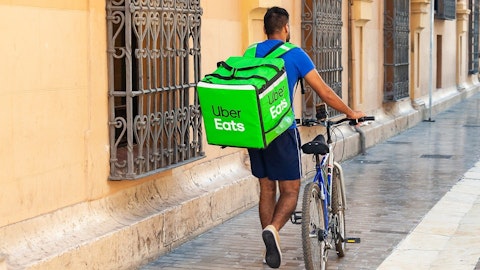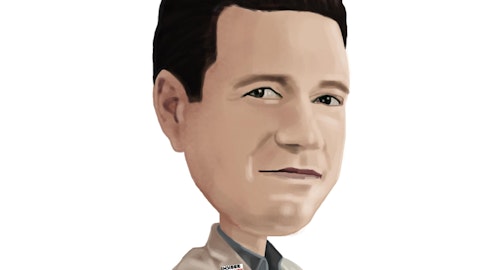Caesarstone Ltd. (NASDAQ:CSTE) Q3 2023 Earnings Call Transcript November 8, 2023
Caesarstone Ltd. misses on earnings expectations. Reported EPS is $-0.2 EPS, expectations were $-0.19.
Operator: Greetings and welcome to the Caesarstone Third Quarter 2023 Earnings Conference Call. At this time all participants are in a listen-only mode. A brief question-and-answer session will follow the formal presentation. [Operator Instructions] As a reminder, this conference is being recorded. It is now my pleasure to introduce your host, Brad Cray, Investor Relations. Thank you. You may begin.
Brad Cray: Thank you, operator, and good morning to everyone on the line. I am joined by Yosef Shiran, Caesarstone’s Chief Executive Officer; and Nahum Trost, Caesarstone’s Chief Financial Officer. Certain statements in today’s conference call and responses to various questions may constitute forward-looking statements. We caution you that such statements reflect only the company’s current expectations and that actual events or results may differ materially. For more information, please refer to the risk factors contained in the company’s most recent annual report on Form 20-F and subsequent filings with the SEC. In addition, on this call, the company will make reference to certain non-GAAP financial measures, including adjusted net loss income, adjusted net loss income per share, adjusted gross profit adjusted EBITDA and constant currency.
A reconciliation of these non-GAAP measures to the most directly comparable GAAP measures can be found in the company’s third quarter 2023 earnings release, which is posted on the company’s Investor Relations website. Thank you. And I would now like to turn the call over to Yosef. Please go ahead.
Yosef Shiran: Thank you, Brad. Good day, and thank you everyone for joining us to discuss our third quarter results. I will discuss our business activity and Nahum will then cover additional details regarding our financial results before we open the call for questions. I would like to start by expressing that we are saddened by the horrific acts of vicious, violence and terror that have occurred in Israel on October 7th. We are confident that Israel will not only prevail, but will also exercise justice towards all who were involved in committing these heinous crimes. Our thoughts are with our employees, customers, and others impacted by these events. We are focused on business continuity and our global operations are running smoothly with no material impact to our strategy, Israeli production and our overall ability to continue serving customers globally.
The one aspect impacted is the market in Israel, which accounted for about 5% of our revenues in the third quarter. We remain committed to supporting the people of Israel and the rehabilitation of our affected townships, and we have decided to donate 2,000 kitchen surfaces to families in the south of Israel whose homes have been lost or damaged during the war, in addition to other supporting activities. Now, we will move to our third quarter results. We generated our third straight quarter of robust cash flow from operations, adding $28.2 million to our year-to-date total of just over $53 million. We maintained our sharp focus on executing further against our global restructuring actions. Our results improved sequentially as we moved through the quarter.
At the same time, we made significant progress with the implementation of various initiatives under our strategic plans to better utilize our resources, improve our cost structure, realign our workforce, and optimize our production footprint. In regards to production optimization, we are on schedule in transitioning production of lower price point SKUs to our strategic network of third-party manufacturers. We have now transitioned a significant portion of our production and expect roughly 40% of our products to be sourced by the end of the year. In addition, we are reaping the initial margin benefits from the closure of our Sdot Yam manufacturing facility, which we completed during the second quarter of this year. In line with this progress, we produced significant sequential recovery in our third quarter adjusted gross margin to 19.8%.
With this operating improvement translating into positive adjusted EBITDA of $1.9 million. Concurrently, we are navigating through complex market dynamics, including a competitive landscape, challenging global economic conditions, and softer trends in innovation and remodel activity across our global footprint. We are working through this challenging environment with an aim to drive higher sales. We are addressing our pricing structure, investing prudently in sales and marketing, and elevating our R&D efforts to create an exciting area of innovative collections that are on track to launch in the coming months. Now I would like to take a moment to comment on recent developments in our Australian market. SafeWork Australia, an Australian government statutory agency, recently made its report about engineered stone publicly available.

This report recommends that the Australian government adapt a ban on engineered stone. The recommendation is pending federal and state government decisions on next steps. At this time, it is difficult to predict exact outcome of the Australian government’s decision on the matter and whether the ultimate decision will be a total ban, partial ban or other. We are working diligently with our strong Australian team to maintain our market share in this market, regardless of the decision. In conclusion, I’m proud of our team and the work that was done this past quarter, both in terms of profitability improvements and restructuring actions. I am confident we are moving in the right direction to transform our business. We now have a much stronger balance sheet that we can leverage to execute our strategy and create value.
Thank you, and I will now turn the call over to Nahum to walk through the details of our financial performance.
Nahum Trost: Thank you, Yosef, and good morning everyone. Looking at our third quarter results, global revenue in the third quarter was $142.4 million compared to $180.7 million in the third quarter of last year. The decrease of 21.2% was primarily driven by softer global market conditions, particularly in the North American renovation and remodel channels, mainly as a result of higher interest rate which has impacted residential spending. In addition, our sales were also impacted by the competitive landscape for our products. The impact of softer residential sales activity, which slowed down commencing in the second half of 2022, has been more pronounced in our results since the second quarter of this year. On a constant currency basis, third quarter revenue was down 20.3%.
The 0.9% difference between US dollar revenues and the constant currency revenues reflect the impact of strong US dollar against our revenues generated in all other markets outside of the US. In the US, sales were down 24.8%, mainly tied to softer residential end markets, particularly for third-party distributors. This was partially offset by higher year-over-year sales with big box customers and improved performance in our commercial business. In our other large markets, Canada’s sales were lower by 17.5% on a constant currency basis, experiencing similar market dynamics as in the US. Australia’s sales were off by roughly 8.4% on a constant currency basis, reflecting slower market conditions, although to a lesser extent. Looking at our third quarter P&L performance, I will start by noting that we produced a significantly higher sequential gross margin as promised.
Our gross margin was 19.1% for the quarter, and the adjusted gross margin was 19.8%, which was similar to our gross margin of 19.7% in the first quarter on lower revenues. Gross margin was lower compared to the 23% in the prior year quarter. The year-over-year decrease in margin mainly reflected the impact of lower revenues, increased manufacturing unit costs, driven by lower fixed cost absorption, mainly related to lower capacity utilization. These factors were partially offset by lower shipping costs and the benefits of our improved production footprint. Operating expenses in the third quarter were $29.2 million compared to $38.5 million in the prior year quarter. Excluding legal settlements, lost contingencies, and restructuring expenses, adjusted operating expenses were 23.7% of revenue compared to 20.9% in the prior quarter.
The higher percentage mainly resulted from lower revenues. Adjusted EBITDA in the third quarter was $1.9 million, improved sequentially compared to the second quarter, in line with our plan to get adjusted EBITDA back to profitability in the second half of the year. The sequential improvement primarily reflects strong operating results for the quarter. Turning to our balance sheet. Caesarstone’s balance sheet as of September 30th, 2023, included cash, cash equivalents and short-term bank deposits and short-term marketable securities of $79.1 million, with a total debt to financial institutions of $6.9 million. During the third quarter, we generated positive cash flow from operations of $28.2 million, mainly driven by our inventory reduction efforts.
This compared to cash flow of $3.5 million in the third quarter of 2022. Our net cash position as of September 30, 2023, was $72.2 million compared to $49 million as of June 30, 2023, and $28.2 million as of December 31, 2022. In regards to the Sdot Yam plant closure, which occurred during the second quarter of 2023, we maintain our expectation to realize annualized savings of approximately $10 million to $15 million. We are still in the process of accepting bids to sublet portions of the non-cancellable lease agreement associated with the Sdot Yam plant, which will allow us to recognize potential cash savings above and beyond the anticipated $10 million to $15 million. In regards to our outlook, we are reiterating our outlook for the full year of 2023 to generate positive cash flow from operations and to end the year with an improved net cash position.
This outlook is based on inventory reductions and other working capital improvements, cost optimization efforts, and our expectation for similar adjusted EBITDA in the fourth quarter compared to the third quarter of 2023. This outlook factors in a significant near-term reduction in Israel revenues due to the war on terror, which as a reminder, could have an impact of up to 5% of our revenues. In summary, our restructuring actions are progressing as planned. We have now a much stronger balance sheet, which leaves us well situated to unlock additional value in our business as we move forward. With that, we are now ready to open the call for questions.
See also 20 States With the Highest Gas Prices in the US and 15 Countries with the Highest Alcohol Consumption in Europe.
Q&A Session
Follow Caesarstone Ltd. (NASDAQ:CSTE)
Follow Caesarstone Ltd. (NASDAQ:CSTE)
Operator: We will now begin the question-and-answer session. [Operator Instructions] The first question is from Reuben Garner of the Benchmark Company. Please go ahead.
Reuben Garner: Thank you. First of all, our thoughts and prayers are with the Caesarstone team and everyone impacted by what happened last month. I guess to start guys, if you don’t mind, I was kind of thinking that maybe there would be not necessarily a step function, but kind of gradual improvement in the margins from the third quarter, or second to the third and then third to the fourth. It sounds like the fourth is going to look more like the third quarter. Is that mostly a function of the impact of Israel or is there any other factors that maybe are not leading to showing improvement on a sequential basis?
Yosef Shiran: So in general — Hi, Reuben, thank you. In general, the 5% or almost 5% that we will not generate in the fourth quarter, according at least to the current situation in the Israeli market will be missing in our overall results. There is also seasonality impact for sales, so Q3 usually is higher than Q4, so we expect low revenues. And on the other side we expect better performance in terms of cost following our restructuring plan. In addition, we are going to invest higher on marketing, so we’ll have higher marketing spend. So all in all, we expect similar EBITDA, but better cost performance and better setup for the future.
Reuben Garner: Okay. And so, just to be clear, your expectation is based on your Israel business essentially going to zero in the near term. Is that right?
Yosef Shiran: It’s not zero. But, first of all, we don’t know yet. We don’t know how the war will continue to develop. So we may — on a positive side, we may incur some positive result. But as it seems now, the market is quite frozen. So we took it as close to zero.
Reuben Garner: Understood.
Nahum Trost: Hi, Ruben. Hey, Reuben, it’s Nahum. And to add to what you said, so despite the near term reduction in the Israeli revenues, we expect to see the normal seasonality that we used to see in previous years. I mean before COVID, before any unusual events. But — so despite the reduction in the Israeli revenues, we expect to see the normal seasonality in Q4. This is something that should be taken into consideration.
Reuben Garner: Got it. And in the prepared remarks, you mentioned up to 40% of your product being manufactured by third-party vendors by year end. What did that number look like coming into 2023?
Yosef Shiran: 40% is in terms of our production, in terms of sales, it’s a bit less because there is time differences. In terms of sales coming into 2023, it was around 20%. And we see a gradual increase over the previous quarter. And we expect to see another increase, gradual increase, in Q4 of this year. But again, 40% is production and not sales. Sales will be lower than 40%.
Reuben Garner: Okay. And you mentioned pricing. I can’t remember the term you used, but that was pricing optimization or pricing initiative of some kind? And then I know you talked about marketing a couple of times. Is your product priced too highly in the market to compete in this environment? What exactly are you leading to there? And then what — are there specific geographies where the marketing expenses being ramped? What’s the kind of, I guess, dollar spend and what the benefit is expected to be from those investments?
Yosef Shiran: Yeah, so there are a few aspects. So first of all the marketing expenses mainly aimed at the US market, but also to other markets. So we are trying to increase our marketing spend in order to elevate the brand and to reach traditional customers. In terms of the production in our strategic partners, third-party strategic partners, so we estimate next year to be at around 50%. So 50% of our production will be produced by our partners. So this will allow us to be more competitive and this will allow us to approach additional channels that we in the past we neglected and are now open to us. And in addition to that we are investing a lot in innovation and this will allow us to compete better across all the fields, also in the higher end, in the middle end, and in the lower end. So this is in a nutshell.
Reuben Garner: And those — the channels, is that big box retail in the US? Is that — what channels are you leading to?
Yosef Shiran: No, so channels, yes, mainly the commercial channels when I say, maybe not neglected, but maybe we went out of most of the commercial channel in the states, so we are going to get back to there. But also to reinforce our other channel, which includes also big box, but also retail, kitchen and bath, and hand stone suppliers that also performed quite bad in the last year.
Reuben Garner: Great. Thanks for the detail, guys, and stay safe. Good luck through the rest of the year.
Yosef Shiran: Thank you.
Nahum Trost: Thanks.
Operator: The next question is from Stanley Elliott of Stifel. Please go ahead.
Stanley Elliott: Hey everybody. Nice to hear your voice. Thank you for the question. Can you all talk about how you see working capital as a percent of sales longer term? I mean, you’ve done a nice job of pulling inventory out. Your relative to historical levels, it would look like you’d still have some ways to go. And now with the model transforming to more of a third party import model for a larger part of the revenue base, just curious where we think working capital could end up here for the business.
Nahum Trost: Hi Stanley, it’s Nahum. Our — we improved working capital specifically in terms of the inventory levels that were elevated last year. And now we’re back to a normalized level, more or less, around 120 inventory days. And we believe, as you said rightfully, that there is still room for improvement and we are aiming to be at an area of around 100 days of inventory. And in general, in terms of percentage of working capital out of revenues, we expect to be around 25% working capital out of revenues.
Stanley Elliott: Perfect. And the comment on the competitive landscape, is that just market? Did you find you maybe were priced too high in certain SKU categories? And then just kind of any detail around kind of the price versus volumes in the quarter that you might have seen, in the US specifically?




